Aloha and welcome! As a seasoned traveler and content creator, I’ve experienced the magic of the Hawaiian Islands across all seasons. One of the most frequent questions I get is about the weather – specifically, what is the Hawaii Weather Year Round like? While the forecast can seem complex due to unique island microclimates, the good news is that Hawaii enjoys remarkably consistent and pleasant temperatures throughout the year. Understanding the general patterns, however, is key to planning your perfect trip, whether you’re chasing waterfalls, lounging on sunny beaches, or exploring volcanic landscapes. Let’s dive into what you can truly expect from Hawaii’s climate, month after month, and how to prepare for its delightful variability.
Current Forecasts and Climate Patterns in Hawaii
Predicting the weather months or even weeks ahead is inherently challenging anywhere, and Hawaii is no exception. However, by examining historical trends and understanding the islands’ unique geographical influences, we can get a clear picture of the typical Hawaii weather year round. Unlike the mainland, Hawaii’s climate is dramatically shaped by its diverse topography – from sea-level beaches to towering volcanic peaks – and the consistent presence of trade winds.
The sheer variety is astounding. For instance, the Big Island alone encompasses nearly all the world’s major climate zones. Kauai boasts one of the wettest spots on Earth at Mount Waiʻaleʻale, recording around 470 inches (1094 cm) of rain annually. Meanwhile, Hilo, on the Big Island, is recognized as the wettest city in the Hawaii, receiving approximately 140 inches (356 cm) each year. These figures might sound daunting, but remember the incredible contrast: just a short distance away, areas like Kekaha on Kauai receive a mere 15-25 inches (40-60 cm) annually. The key takeaway? Weather is highly localized.
Visitors are often surprised by how quickly conditions can change. One moment, you might be in a brief, refreshing shower, and the next, the sun is shining brightly, often creating a stunning rainbow. This isn’t just random; it’s a characteristic feature of the tropics and Hawaii’s specific geography. Don’t be alarmed if a forecast shows rain every day; this usually signifies intermittent, short-lived showers, not a continuous downpour that will ruin your vacation.
Hawaii Annual Rainfall and Average Temperatures
Understanding the average temperatures and rainfall patterns gives travelers a solid foundation for planning their visit, no matter the time of year. While conditions vary from island to island and even within different areas of the same island, these averages provide a statewide estimate and highlight the general consistency of Hawaii weather year round.
Below is a table summarizing the average monthly temperatures (High/Low in Fahrenheit) and precipitation (in inches) across the state and for the primary reporting locations on the major islands.
| Hawaii Island | Jan | Feb | Mar | Apr | May | Jun | Jul | Aug | Sept | Oct | Nov | Dec |
|---|---|---|---|---|---|---|---|---|---|---|---|---|
| Statewide | 80/65°F 4.5″ | 80/65°F 3.5″ | 80/66°F 4.2″ | 81/68°F 3.7″ | 83/69°F 2.6″ | 85/71°F 2.0″ | 85/72°F 2.9″ | 86/72°F 2.7″ | 86/72°F 2.7″ | 85/71°F 3.5″ | 83/69°F 4.4″ | 81/67°F 4.5″ |
| Oahu | 80/66°F 2.7″ | 81/65°F 2.3″ | 82/67°F 1.9″ | 83/68°F 1.1″ | 85/70°F 0.8″ | 87/72°F 0.4″ | 88/74°F 0.5″ | 89/75°F 0.4″ | 89/74°F 0.7″ | 87/73°F 2.1″ | 84/71°F 2.2″ | 82/68°F 2.8″ |
| Maui | 80/63°F 3.7″ | 81/63°F 2.3″ | 81/65°F 2.3″ | 83/66°F 1.7″ | 84/67°F 0.6″ | 86/69°F 0.2″ | 87/71°F 0.5″ | 88/71°F 0.5″ | 88/70°F 0.4″ | 87/69°F 1.1″ | 84/68°F 2.1″ | 82/65°F 3.1″ |
| Kauai | 78/65°F 4.5″ | 78/66°F 3.2″ | 78/67°F 3.5″ | 79/69°F 3.0″ | 81/70°F 2.8″ | 83/73°F 1.8″ | 84/74°F 2.1″ | 85/74°F 1.9″ | 85/74°F 2.6″ | 83/73°F 4.2″ | 81/71°F 4.7″ | 79/68°F 4.7″ |
| Big Island (Kona) | 81/66°F 1.7″ | 81/66°F 0.9″ | 82/67°F 1.1″ | 83/69°F 0.5″ | 84/70°F 0.6″ | 85/72°F 0.4″ | 86/73°F 0.6″ | 87/73°F 0.8″ | 86/73°F 0.7″ | 86/72°F 0.6″ | 84/70°F 0.9″ | 82/68°F 1.8″ |
| Big Island (Hilo) | 79/64°F 9.8″ | 79/64°F 9.0″ | 79/65°F 12.1″ | 79/66°F 12.4″ | 81/67°F 8.0″ | 82/68°F 7.6″ | 82/69°F 10.8″ | 83/69°F 9.8″ | 83/69°F 9.1″ | 83/69°F 9.7″ | 81/67°F 12.1″ | 79/65°F 10.3″ |
Note: These figures represent averages, and actual daily conditions can vary significantly. Temperature is in Fahrenheit, precipitation in inches.
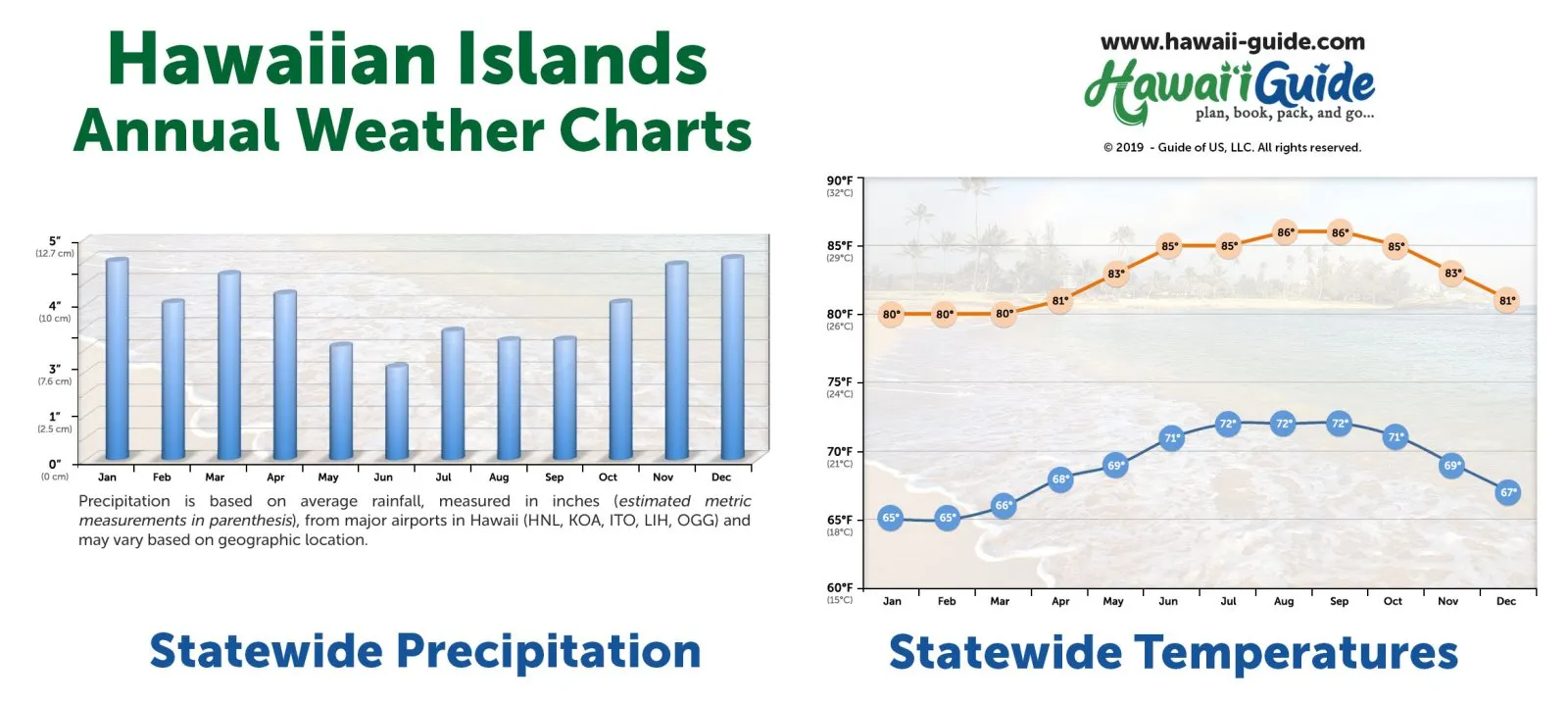
Hawaii Statewide Weather Average Temperature and Rainfall Year Round
Hawaii Weather Year Round: Average temperature and rainfall across the islands provide a snapshot of the typical climate patterns.
These numbers highlight that temperatures remain warm and inviting throughout the year. While rainfall varies, particularly between the wet (windward, northeast) and dry (leeward, southwest) sides of the islands, the average precipitation for most visitor-friendly areas is quite low, especially during the summer months.
General Hawaii Weather Patterns Year Round
One of the most fascinating aspects of the Hawaii weather year round is its hyper-localized nature. You can literally drive a few miles and experience a complete shift in conditions, moving from sunshine to rain and back again. This geographical lottery allows for incredible scenic diversity – from sun-drenched coasts to misty mountain valleys, lush rainforests, and even snow-capped peaks at high elevations.
What to Eat in Fort Worth – A Culinary Deep Dive
Discover the Top Restaurants in Denver – A Culinary Journey
Discover Where to Visit in Las Vegas
While local forecasts are essential for day-to-day planning, understanding the general patterns helps manage expectations for your trip anytime you visit. The primary influence on Hawaii’s weather is the trade winds, which typically blow from the northeast or east-northeast. These winds bring moisture from the ocean, which is then lifted by the islands’ mountains. As the air rises, it cools and releases precipitation on the windward sides.
The leeward sides, sheltered by the mountains, remain significantly drier and sunnier. This creates the distinct wet-on-one-side, dry-on-the-other pattern seen on all the major islands. Most resorts and populated areas are located on the drier, leeward coasts, ensuring plenty of sunshine for beach activities year-round.
Sometimes, the trade winds slacken or reverse, resulting in winds from the south. These are known as Kona winds. Kona winds can bring hot, humid, and sometimes muggy conditions, occasionally leading to widespread rain or thunderstorms, particularly affecting the leeward (Kona) sides which are normally dry.
While the idea of a strict “wet season” or “dry season” in Hawaii is an oversimplification, there are general trends. The winter months (roughly November to March) tend to see more frequent and sometimes heavier rain, particularly on the windward coasts and at higher elevations. However, even during this period, rain showers are often brief, followed quickly by sunshine.
The summer months (roughly April to October) are generally drier and warmer, with consistent sunshine, especially on leeward coasts. Humidity can be higher during the summer. However, historical data shows variability; it can be dry in winter and experience heavy rain events in summer. The important point is not to assume a full washout based on a general “rainy season” label; the reality of Hawaii weather year round is much more nuanced and often favorable.
Hawaii Year-Round Temperatures
One of the biggest draws for visiting Hawaii is its consistently pleasant temperatures. Regardless of the month, you can expect warm conditions suitable for swimming, sunbathing, and outdoor activities. The variation between the warmest and coolest months at sea level is quite small.
At sea level, average daytime high temperatures typically range from the upper 70s Fahrenheit (around 25°C) in the winter months to the mid-80s Fahrenheit (around 29-30°C) in the summer. Nighttime temperatures are generally about 10-15°F (6-8°C) cooler than daytime highs, providing comfortable evenings.
However, it’s crucial to remember the impact of elevation. For every 1,000 feet (approx. 300 meters) of elevation gain, the temperature drops by about 3.5°F (approx. 2°C). This means areas at higher altitudes, like Volcano Village on the Big Island, Kokeʻe on Kauai, or the slopes of Haleakalā on Maui, will be significantly cooler, especially at night or in the early morning.
Visitors planning to visit summits like Haleakalā (Maui) or Mauna Kea (Big Island) need to be prepared for cold temperatures, even freezing conditions, and potentially snow during winter. At elevations exceeding 10,000 feet (3,000 meters), warm layers, hats, and gloves are essential year-round, as temperatures can be near or below freezing. Even at moderate elevations (3,000-4,000 feet), a light jacket or sweater is advisable for evenings.
Ocean temperatures are also consistently warm, making swimming and water sports enjoyable any time of year. Surface water temperatures typically range from about 74°F (23°C) in the cooler winter months to a comfortable 80°F (27°C) or higher in the summer.
El Niño and La Niña Effects on Hawaii Weather
Large-scale climate phenomena like El Niño and La Niña can influence Hawaii’s weather patterns year round, particularly rainfall during the winter months.
During El Niño years, the central Pacific jet stream shifts, often leading to drier-than-average conditions across the Hawaiian Islands, especially during the typical wet season (winter). This can mean less rain, more sunshine, and potentially warmer temperatures.
Conversely, La Niña years are often associated with wetter-than-average conditions in Hawaii during the winter. The trade winds may be stronger, bringing more moisture to the windward coasts. Sometimes, this increased rainfall can even extend later into the spring months than usual.
While these are general tendencies, the actual impact can vary, and not every El Niño or La Niña event affects Hawaii in the same way. Local forecasts and climate outlooks provide the most current information regarding these larger weather influences.
Hurricane Season in Hawaii
Hawaii has a relatively low risk of direct hurricane strikes compared to other tropical regions. However, it is still located within the Central Pacific hurricane basin, and a hurricane season exists. The official hurricane season runs from June 1st to November 30th.
During this period, tropical cyclones can form in the Eastern or Central Pacific and potentially track towards the islands. While direct hits are rare, Hawaii can experience indirect effects such as increased humidity, higher surf, stronger winds, and heavy rainfall from storms passing nearby.
Monitoring tropical weather outlooks is advisable if visiting during hurricane season, but it’s important to remember that most visits during this period occur without encountering any tropical storm activity. The infrastructure and emergency services in Hawaii are prepared for such events, and official warnings are issued well in advance if needed.
Hawaiian Islands Weather Charts
To provide a clearer visual understanding of Hawaii weather year round on each major island, let’s look at some specific charts showing annual precipitation and temperatures.
Kauai Weather, Forecast, & Charts
Known as the “Garden Isle” due to its lush, verdant landscapes, Kauai’s weather reflects its nickname. While Mount Waiʻaleʻale in the interior is exceptionally wet, most visitor areas on the coast enjoy plenty of sunshine. Accommodations are primarily found on the drier South Shore (Poipu), the sunnier East Coast (Lihue, Kapaʻa), and the beautiful but wetter North Shore (Hanalei, Princeville). The North Shore sees more rain, especially in winter, contributing to its stunning green cliffs and waterfalls.
Average temperatures on Kauai generally range from highs of 78-85°F (25-29°C) and lows of 65-74°F (18-23°C) year-round, depending on location and elevation.
 Lihue, Kauai Average Temperatures Year Round
Lihue, Kauai Average Temperatures Year Round
Average temperatures in Lihue, Kauai, showing consistent warmth reflecting the Hawaii weather year round pattern at sea level.
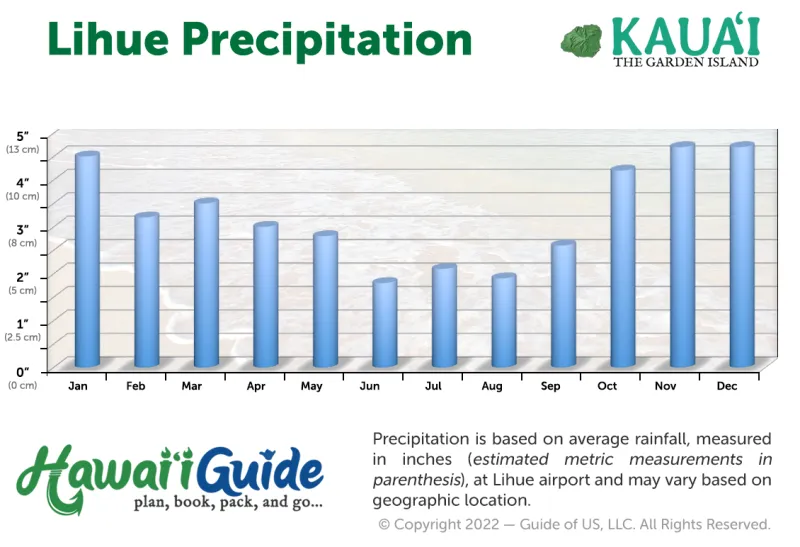 Lihue, Kauai Average Precipitation Year Round
Lihue, Kauai Average Precipitation Year Round
Average monthly precipitation in Lihue, Kauai, indicating slightly higher rainfall in winter months as part of Hawaii weather year round.
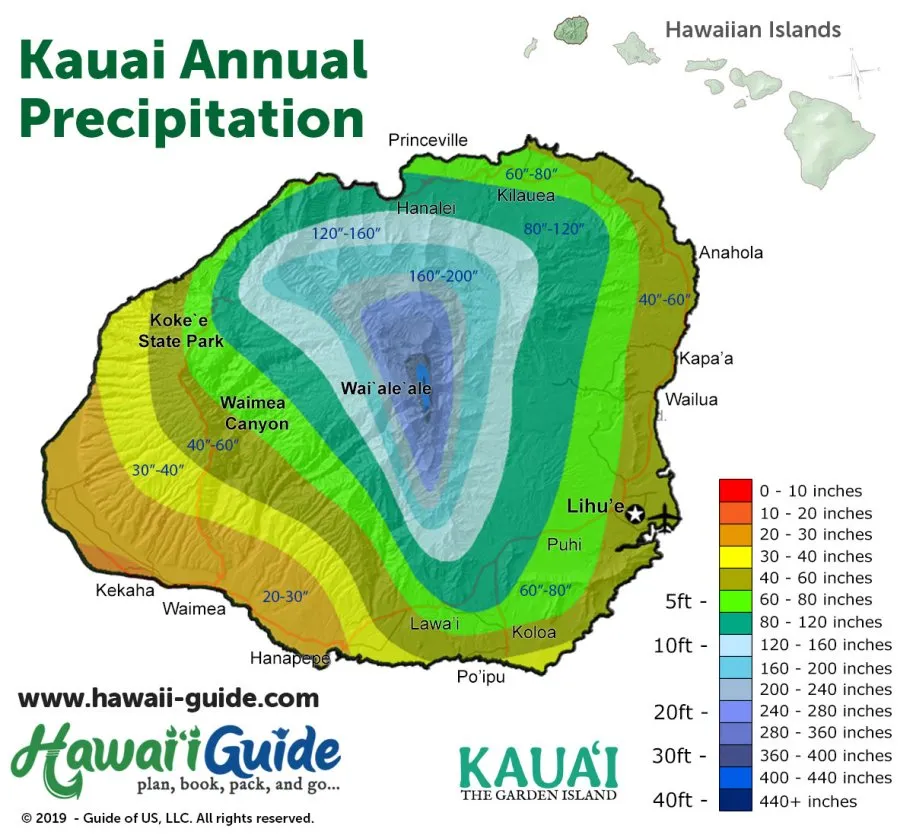 Kauai Annual Precipitation Map showing wet and dry areas
Kauai Annual Precipitation Map showing wet and dry areas
Kauai Annual Precipitation Map illustrating the dramatic difference in rainfall between the island’s windward (northeast) and leeward (southwest) sides.
Oahu Weather, Forecast, & Charts
Oahu, known as “The Gathering Place,” is often the driest of the main Hawaiian islands, particularly in popular areas like Honolulu and Waikiki. Sunshine is abundant on the leeward coast, making it a reliable choice for beach lovers anytime. Most visitor accommodations are centered around Honolulu and Waikiki.
Other regions like the North Shore (Haleiwa, Turtle Bay) and the Windward East (Kaneohe, Kailua) experience more rain, especially during winter, though still often in brief showers. The Leeward Waianae coast can also be quite dry and hot.
Oahu’s temperatures are consistently warm, with average highs ranging from 80-89°F (27-32°C) and lows from 65-75°F (18-24°C), characteristic of the general Hawaii weather year round trend at sea level.
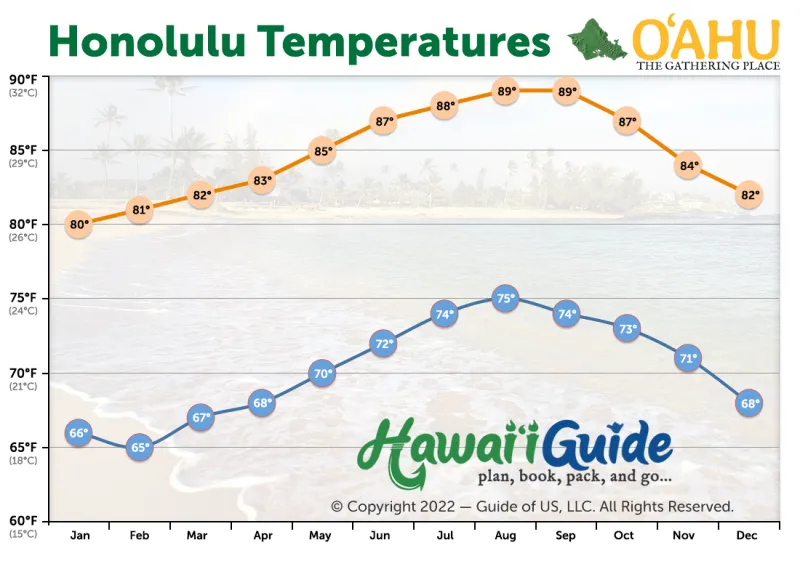 Honolulu, Oahu Average Temperature Year Round
Honolulu, Oahu Average Temperature Year Round
Average temperatures in Honolulu, Oahu, consistently warm throughout the year, showcasing the stable Hawaii weather year round climate.
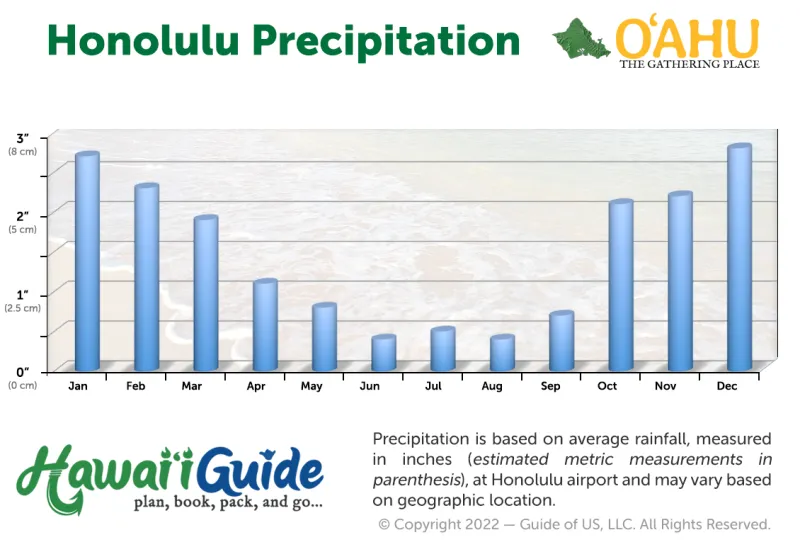 Honolulu, Oahu Average Precipitation Year Round
Honolulu, Oahu Average Precipitation Year Round
Average monthly precipitation in Honolulu, Oahu, demonstrating low rainfall totals, especially during the summer months.
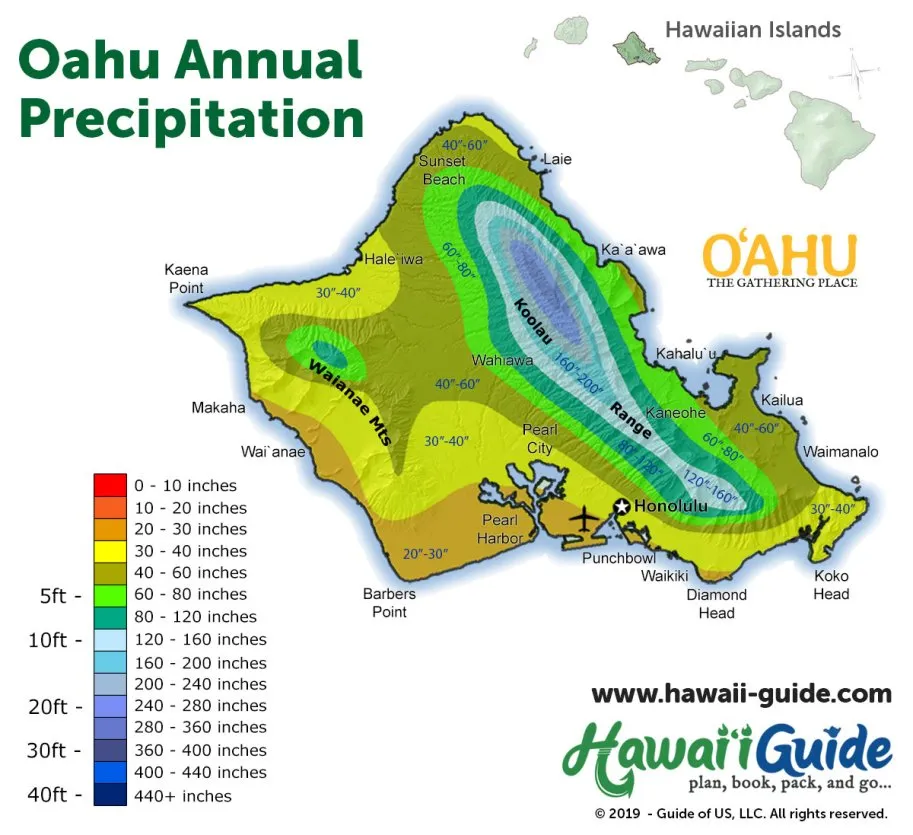 Oahu Annual Precipitation Map highlighting dry southwestern coast
Oahu Annual Precipitation Map highlighting dry southwestern coast
Oahu Annual Precipitation Map illustrating the significantly drier conditions on the southwestern (leeward) side, including Honolulu.
Maui Weather, Forecast, & Charts
Maui, the “Valley Isle,” offers a diverse climate experience influenced by the West Maui Mountains and the massive Haleakalā volcano. The popular resort areas on the South Shore (Kihei, Wailea, Makena) and West Maui (Lahaina, Ka’anapali, Kapalua) are typically sunny and dry year-round.
The windward side, particularly the route along the Hana Highway, is much wetter and lush, especially in winter, fueling its numerous waterfalls. Higher elevations on Haleakalā are much cooler.
Average temperatures on Maui range from highs of 80-88°F (27-31°C) and lows of 63-71°F (17-22°C) at sea level, consistent with the overall Hawaii weather year round patterns.
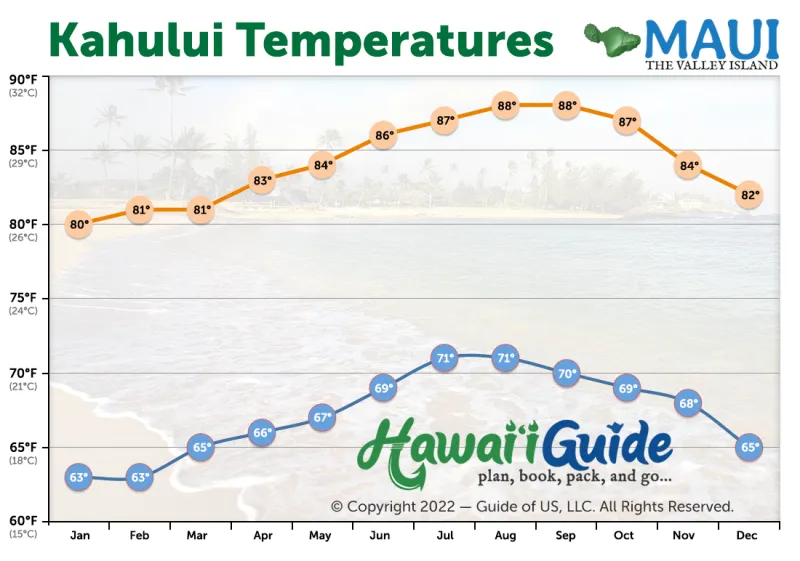 Kahului, Maui Average Temperatures Year Round
Kahului, Maui Average Temperatures Year Round
Average temperatures in Kahului, Maui, reflecting the warm and stable Hawaii weather year round near sea level.
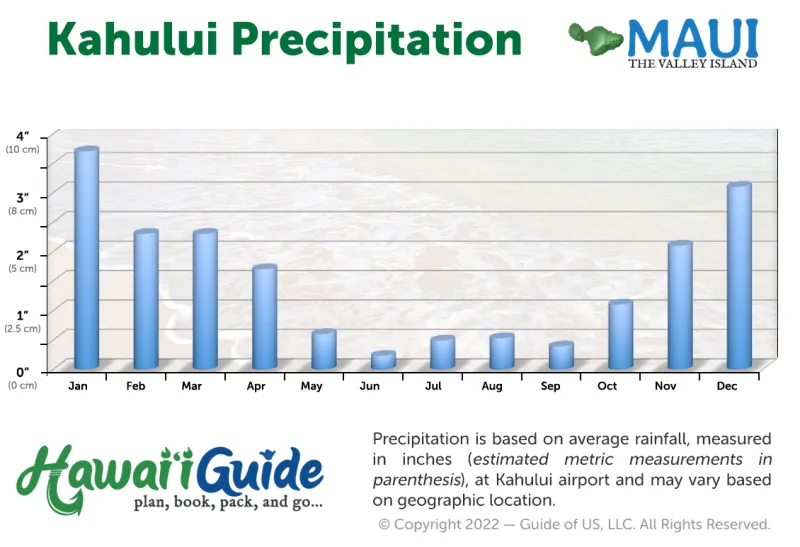 Kahului, Maui Average Precipitation Year Round
Kahului, Maui Average Precipitation Year Round
Average monthly precipitation in Kahului, Maui, showing relatively low rainfall throughout the year, especially compared to windward areas.
 Maui Annual Precipitation Map detailing wet and dry regions
Maui Annual Precipitation Map detailing wet and dry regions
Maui Annual Precipitation Map highlighting the stark contrast between the dry leeward coasts and the very wet windward (Hana) side.
Big Island Weather, Forecast, & Charts
The Big Island of Hawaii is perhaps the most climatically diverse, featuring everything from tropical rainforests to deserts and alpine tundra across its 11 distinct climate zones. Coastal areas, where most resorts are located (primarily on the leeward Kona side), are typically warm and sunny year-round.
The windward Hilo side is famously wet and lush. Higher elevations around Volcano Village and the summits of Mauna Loa and Mauna Kea are significantly cooler, with potential for frost or snow. Packing for varied conditions is essential on the Big Island.
Temperatures vary greatly by location. In Hilo (windward), average highs are 79-83°F (26-28°C) and lows 64-69°F (18-21°C). In Kailua-Kona (leeward), average highs are 81-87°F (27-31°C) and lows 66-73°F (19-23°C). The summits can see temperatures drop well below freezing.
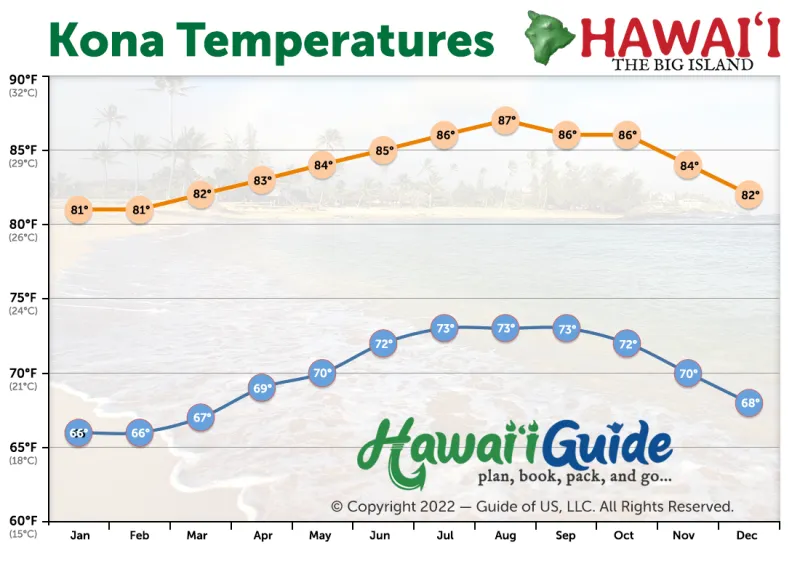 Kailua-Kona, Big Island Average Temperatures Year Round
Kailua-Kona, Big Island Average Temperatures Year Round
Average temperatures in Kailua-Kona, on the west side of the Big Island, showing consistently warm conditions typical of a leeward coast.
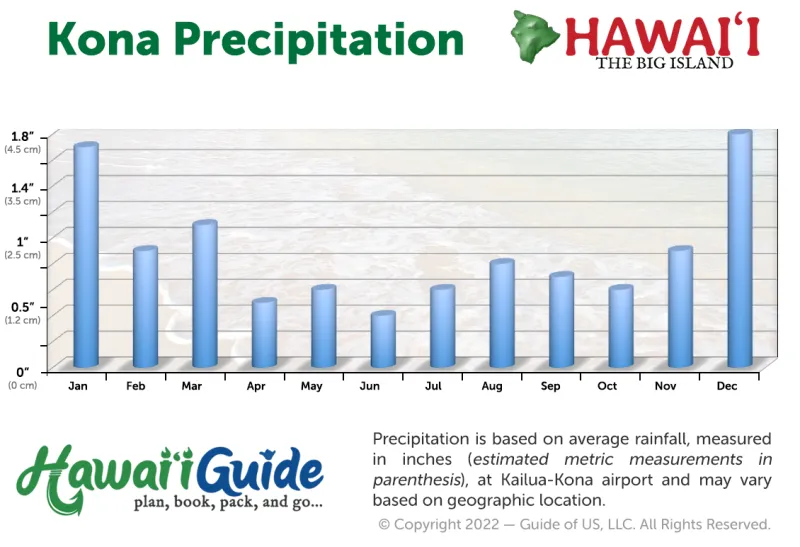 Kailua-Kona, Big Island Average Precipitation Year Round
Kailua-Kona, Big Island Average Precipitation Year Round
Average monthly precipitation in Kailua-Kona, Big Island, highlighting its status as one of the driest areas in Hawaii year round.
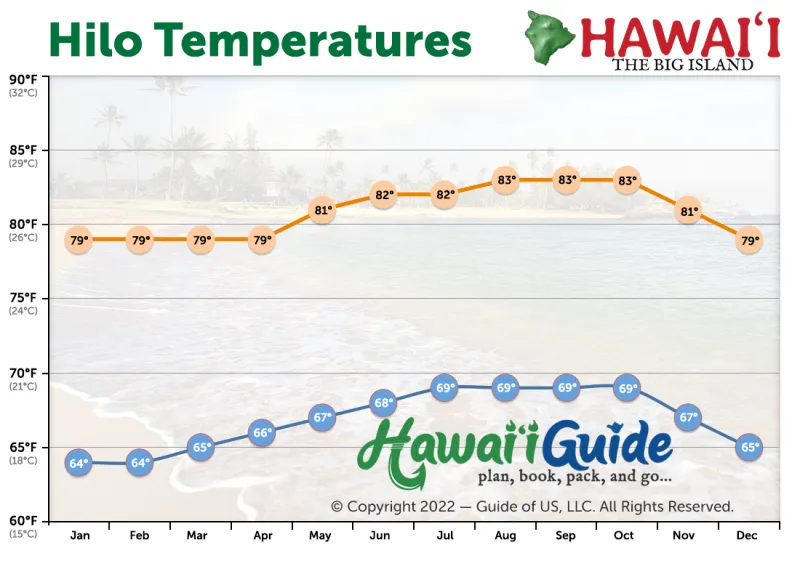 Hilo, Big Island Average Temperature Year Round
Hilo, Big Island Average Temperature Year Round
Average temperatures in Hilo, on the east side of the Big Island, showing slightly lower temperatures than Kona and consistent with a windward location.
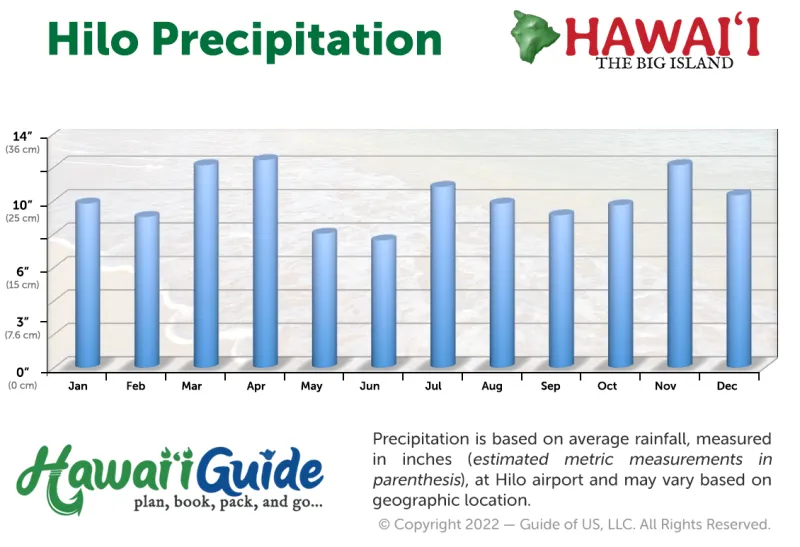 Hilo, Big Island Average Precipitation Year Round
Hilo, Big Island Average Precipitation Year Round
Average monthly precipitation in Hilo, Big Island, clearly showing its much higher rainfall throughout the year compared to the Kona side.
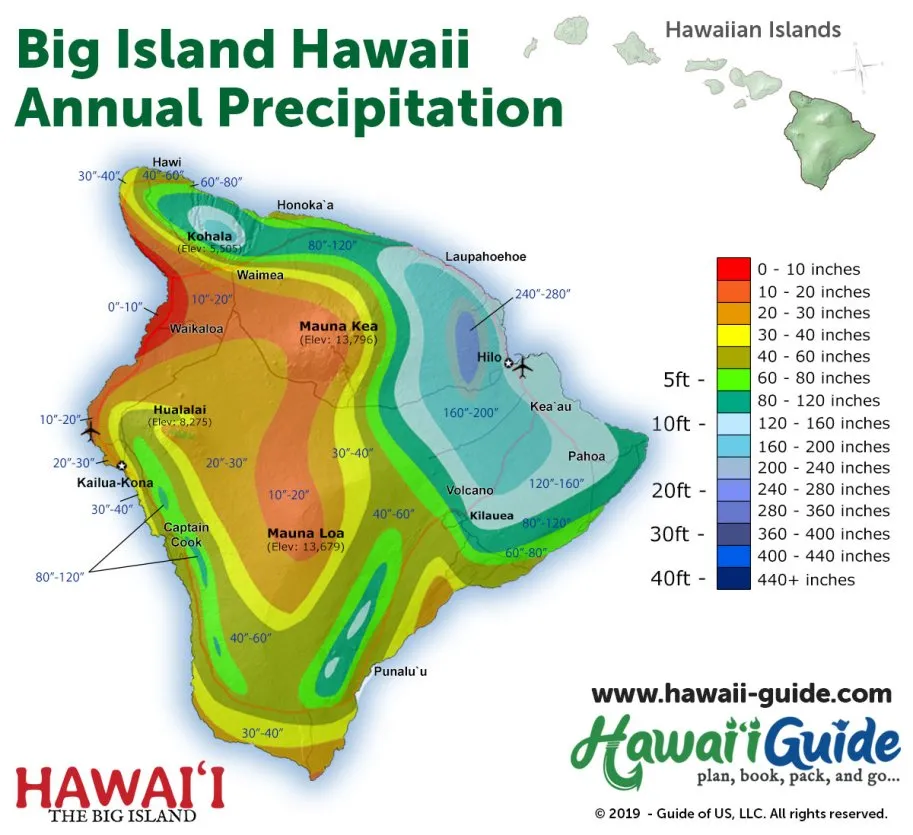 Big Island Annual Precipitation Map illustrating diverse climate zones
Big Island Annual Precipitation Map illustrating diverse climate zones
Big Island Annual Precipitation Map showcasing the extreme variation in rainfall across the island, from wet Hilo to dry Kona and high elevation zones.
Additional Hawaii Weather Graphics
These additional graphics further illustrate the general patterns and averages across the Hawaiian Islands, reinforcing the picture of Hawaii weather year round.
 Hawaii Annual Precipitation Maps by Island
Hawaii Annual Precipitation Maps by Island
Annual precipitation maps for each Hawaiian Island side-by-side, visually demonstrating the windward/leeward rainfall differences that define Hawaii weather year round.
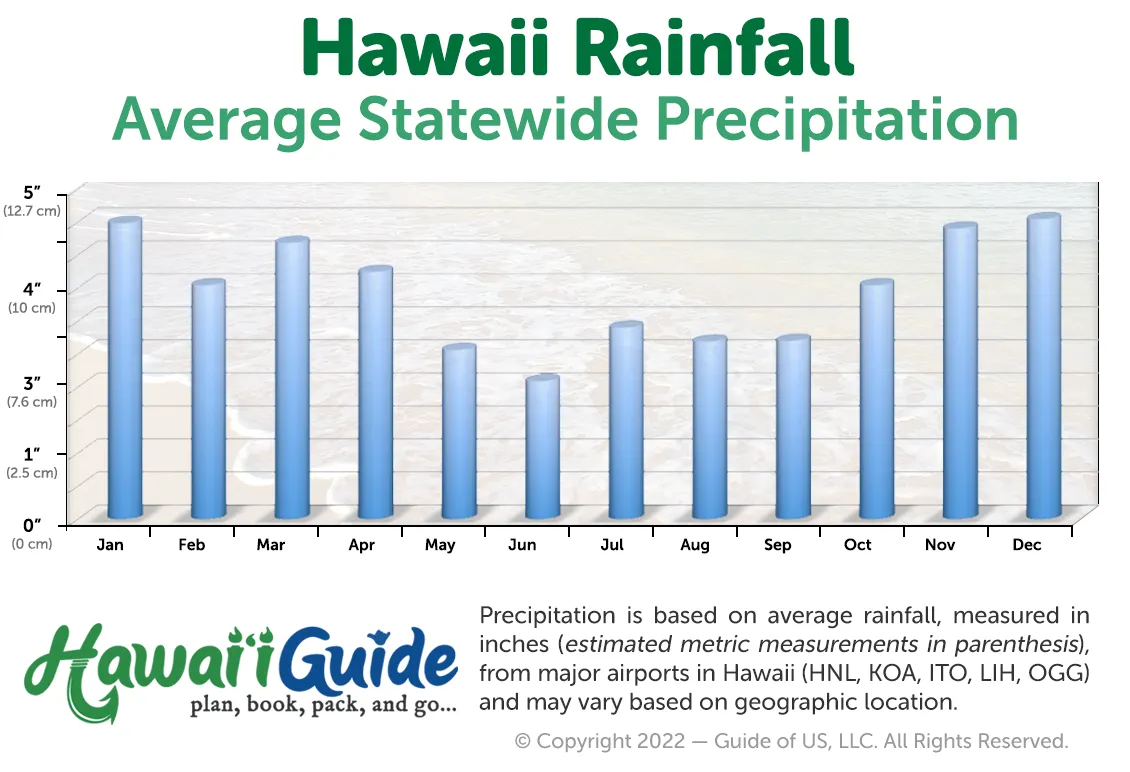 Average Hawaii Rainfall Year Round Chart
Average Hawaii Rainfall Year Round Chart
Chart depicting average annual rainfall for the reporting locations on each island, providing a simple comparison of wetness.
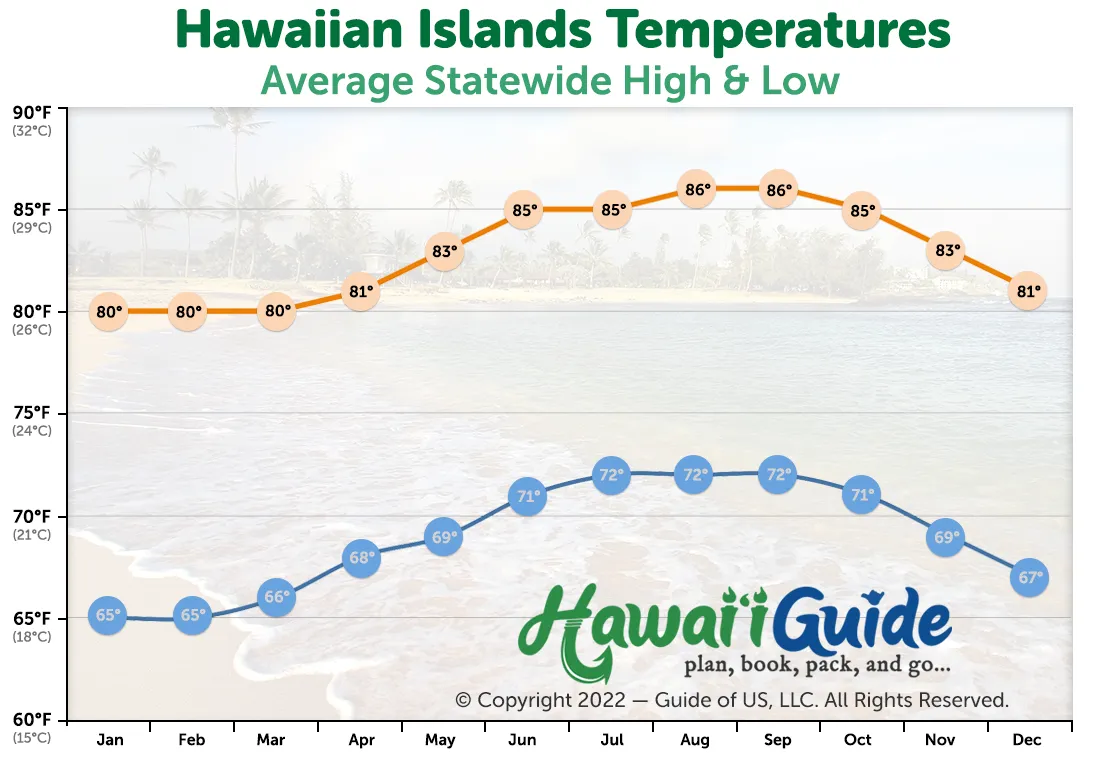 Average Hawaii Temperatures Year Round Chart
Average Hawaii Temperatures Year Round Chart
Chart showing average annual temperatures for the reporting locations on each island, highlighting the consistent warm climate of Hawaii weather year round at lower elevations.
 Statewide Hawaii Annual Precipitation Overview
Statewide Hawaii Annual Precipitation Overview
Statewide Hawaii Annual Precipitation Map offering a broader view of rainfall distribution across the entire archipelago.
Practical Tips and What to Pack
Given the localized nature of Hawaii weather year round, the best advice is to check forecasts for the specific area you will be in, rather than relying on a single island-wide report. Websites focusing on Hawaii weather, like the University of Hawaii’s meteorology department site, often provide more detailed and accurate local forecasts.
Packing layers is always a good idea. While swimwear and light clothing are staples, include a light jacket or sweater, especially if you plan to visit higher elevations or are traveling during the cooler winter months. If you plan on hiking in wetter areas or during the winter, a small, packable rain jacket or poncho can be very useful.
Remember that most rain in Hawaii is brief and often happens at night or in the early morning. If you encounter a shower during the day, chances are it will pass quickly, leaving behind rainbows and fresh, clean air. Don’t let the possibility of rain deter you from enjoying your outdoor activities.
Frequently Asked Questions about Hawaii Weather Year Round
Is there a rainy season in Hawaii?
While there isn’t a strictly defined rainy season like in some tropical destinations, the winter months (November to March) generally see more frequent rainfall, particularly on the windward (northeast) sides of the islands. The summer months (April to October) are typically drier and sunnier, especially on the leeward (southwest) coasts. However, brief showers can occur anytime year-round.
What is the best time to visit Hawaii for good weather?
The best time for weather often depends on your preference. For the driest and sunniest conditions at lower elevations, the summer months (April to October) are generally ideal. For slightly cooler temperatures and potentially larger surf on north shores (good for surfing), the winter months can be appealing, although rain is more likely. The consistently pleasant Hawaii weather year round means there’s no truly “bad” time to visit in terms of temperature.
How does elevation affect the weather in Hawaii?
Elevation has a significant impact. For every 1,000 feet gained, the temperature drops about 3.5°F. This means mountain areas and volcanic summits are considerably cooler than coastal regions. High-elevation areas can experience frost and even snow, especially in winter. Always check the forecast for the specific elevation you plan to visit.
Are hurricanes common in Hawaii?
Direct hurricane strikes on Hawaii are rare. The official hurricane season is June 1st to November 30th, and while tropical cyclones can form or pass near the islands during this time, the central Pacific is less active than other ocean basins, and the islands’ location offers some protection. Monitoring forecasts during this period is advised, but the likelihood of a vacation being severely impacted by a hurricane is low.
Conclusion
Ultimately, when considering Hawaii weather year round, the key takeaway is consistency and localization. Temperatures at sea level remain warm and inviting throughout the months, perfect for enjoying the beaches and ocean. While some areas, particularly windward coasts and high elevations, receive significant rainfall, the popular visitor areas on the leeward sides remain remarkably sunny and dry.
Understanding these patterns allows you to choose the best island or area for your preferred climate or simply pack wisely to experience the stunning diversity Hawaii offers. Don’t let a forecast predicting scattered showers worry you; those brief moments of rain are often followed by glorious sunshine and the appearance of beautiful rainbows. So, come prepared for variety, but expect plenty of warmth and sunshine whenever you choose to explore these incredible islands. Hawaii’s weather is as much a part of its unique charm as its culture, history, and breathtaking landscapes.
